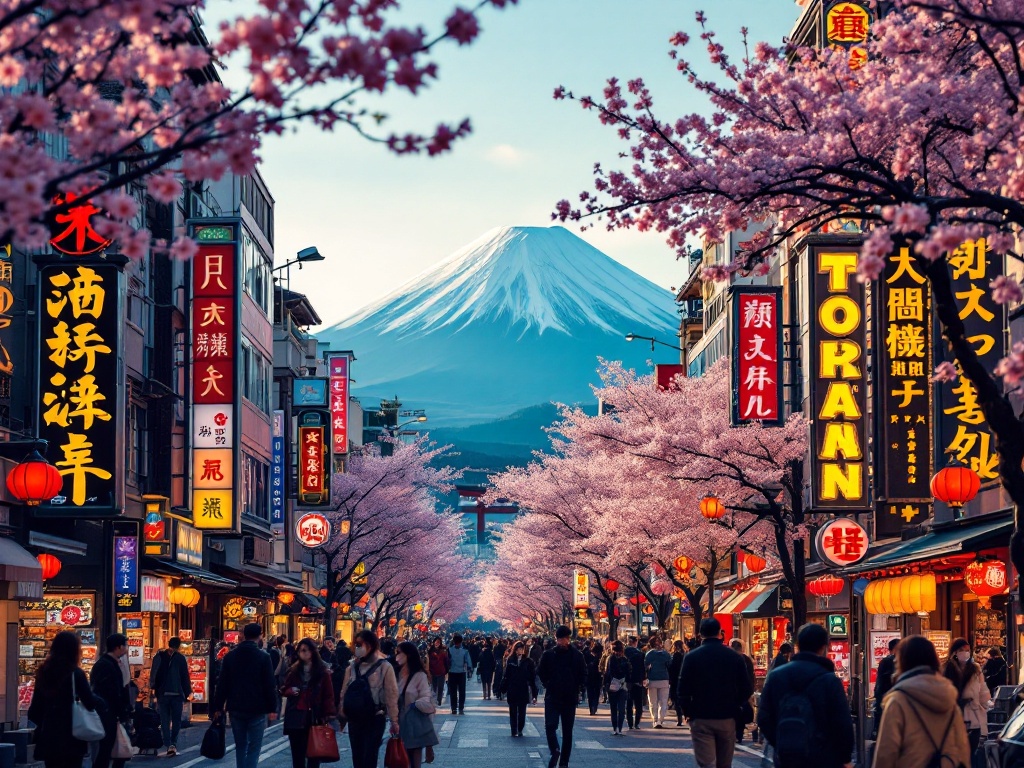Essential Tips for Traveling to Japan
Dreaming of exploring Japan? From the bustling streets of Tokyo to the serene beauty of Mount Fuji, this guide helps you plan the perfect trip! Discover how to secure a visa-free stay for up to 90 days, navigate the efficient public transport system with a Japan Rail Pass, and experience the magic of cherry blossom season (or the less crowded autumn alternative). Learn essential etiquette tips, like bowing and chopstick customs, and prepare for a culturally immersive experience. Start your Japanese adventure today!
Important information

- Confirm your passport validity and Japan’s visa requirements for your nationality. Citizens of 68 countries can enter visa-free for up to 90 days.
- Book accommodations well in advance, especially during peak seasons like cherry blossom season (late March to early May) or Golden Week (late April to early May), for better availability and deals. Autumn offers beautiful scenery with fewer crowds.
- Purchase a Japan Rail Pass for cost-effective travel on JR trains, including the Shinkansen bullet train. Use IC cards like SUICA for easy payment on local transport, in convenience stores, and at vending machines.
- Cash is essential, especially outside major cities. Exchange currency before your trip or use ATMs at 7-Eleven stores, post offices, and banks. Inform your bank of your travel dates.
- Learn basic Japanese etiquette: bow as a greeting, queue politely, remove shoes indoors, and understand chopstick rules. Tipping is not customary. Say “Itadakimasu” before eating and “Gochisosama deshita” after finishing a meal.
Planning Your Trip to Japan
Planning a trip to Japan? Start with your passport and ensure it’s valid. You’ll also need to check visa requirements. Citizens of 68 countries enjoy up to 90 days visa-free, but confirming this is always wise. Next, book your accommodations in advance—it’s highly recommended. Finally, consider a Japan Rail Pass for convenient and cost-effective travel throughout the country.
Check your passport’s validity.
Review Japan’s visa requirements for your nationality.
Book your accommodations in advance.
Consider purchasing a Japan Rail Pass.
Best Time to Visit: Cherry Blossom Season and Golden Week
Japan’s cherry blossoms peak in late March and early May, coinciding with the busy and expensive Golden Week holiday (late April to early May). Spring is undeniably beautiful.
Autumn (September to November) presents a pleasant alternative with equally stunning scenery and fewer crowds. Consider autumn for a less crowded and potentially more affordable travel experience.
Check Passports and Visa Requirements
Citizens of 68 countries can explore Japan visa-free for up to 90 days. However, confirming your country’s specific requirements beforehand is essential. Ensure your passport’s validity covers your entire trip to avoid any unexpected issues.
Booking Accommodation in Advance
To secure your lodging, especially during peak seasons like cherry blossom time or Golden Week, book well in advance. This not only guarantees availability but can also unlock better deals.
Consider Purchasing a Japan Rail Pass
A Japan Rail Pass offers unlimited access to JR trains, including the Shinkansen bullet train, providing significant savings for extensive travel throughout Japan. This flexible pass allows for spontaneous trips and eliminates the need for individual tickets, simplifying your travel experience.
Pre-Departure Essentials
Traveling to Japan? Here’s how to prepare:
Safeguard your trip with travel insurance. This protects you from unforeseen issues like medical emergencies and cancellations.
Consult your doctor. Discuss necessary vaccinations and medications before your trip.
Prepare a compact first-aid kit. Include essential medical supplies.
Plan your luggage with a detailed list. This prevents overpacking.
Pack versatile, layered clothing. This is ideal for Japan’s varied climate.
Choose comfortable shoes. These are vital for extensive walking.
Exchange currency in advance. Cash is king in Japan.
Alert your bank about your travel dates. This helps avoid card complications. Airports and banks in Japan also offer currency exchange services.
Secure internet access. A data-rich SIM card or pocket WiFi are excellent options for navigation, translation, and communication.
Travel Insurance and Health Precautions
Travel with peace of mind by securing comprehensive travel insurance. It covers trip cancellations, medical emergencies, and lost luggage. For trips to remote areas, consider adding medical evacuation coverage. Before your trip to Japan, consult your doctor regarding recommended vaccinations and necessary precautions. Pack all essential prescription medications and a basic first-aid kit for minor ailments.
Packing Light and Creating a Packing List
Planning a trip to Japan? Pack light! Smaller accommodations and efficient public transport make packing light essential for easy travel. A packing list can help you avoid overpacking.
Currency and Cash Culture: Japanese Yen and Cash Payments
In Japan, the official currency is the yen (JPY). While credit cards are increasingly accepted in major cities, cash remains essential, particularly in smaller towns and rural areas. Many local shops and businesses still primarily operate on a cash basis.
Data-Heavy SIM Card and Pocket Wifi Options
Stay connected throughout your Japan trip! Find data-heavy SIM cards at major airports like Narita, Haneda, and Kansai, or rent a pocket wifi device for convenient connectivity.
Travel Tips for First-Time Visitors
Japan has distinct seasonal changes and regional climate variations, so packing light jackets, sweaters, and comfortable shoes is recommended. Layering your clothing offers adaptability.
Earthquake preparedness is essential: familiarize yourself with safety procedures and evacuation routes. A small emergency kit containing water, snacks, and a flashlight is also wise.
Before your trip, research the specific climate of your destination.
Carrying Japanese yen is necessary for smaller establishments and vending machines. Currency exchange is available at banks, airports, and certain hotels; checking exchange rates beforehand can secure a more favorable rate.
Weather Preparation and Clothing Recommendations
Packing for Japan’s diverse climate requires a strategic approach. Prioritize light, layered clothing for adaptability. A waterproof jacket is essential for unexpected showers. Comfortable shoes are crucial for extensive walking.
Earthquake Preparedness and Health and Safety
Familiarize yourself with your hotel’s safety and evacuation procedures, as earthquakes are frequent in Japan.
Prepare a small first-aid kit containing any essential medications.
Register with your embassy upon arrival in Japan.
Remember that the Japan Meteorological Agency issues potentially lifesaving early earthquake warnings.
Cash Withdrawal and Currency Exchange Tips
Cash is still widely used in Japan, particularly at smaller establishments and local shops. For convenient access to Japanese Yen, consider these options:
ATMs
Withdraw cash from ATMs conveniently located in 7-Eleven stores, post offices, and Japanese banks. These ATMs typically offer English menus and accept international cards.
Currency Exchange
Exchange currency before your trip or upon arrival at major airports like Narita (NRT) and Haneda (HND). Airport exchange counters often have longer operating hours than banks.
Getting Around: Transportation Tips
Japan’s public transportation system is exceptional. The Shinkansen, or bullet train, provides rapid intercity travel, while local trains and subways efficiently navigate urban areas. For exploring multiple cities, a Japan Rail Pass can be a cost-effective choice. Consider using an IC card like SUICA for seamless travel.
Benefits of Using a Japan Rail Pass
- Cost-effective for multi-city travel.
- Extensive network coverage.
- Reserved seating options.
Advantages of IC Cards (e.g., SUICA)
- Simplified payment for public transport.
- Usable on trains, buses, and subways.
- Accepted at convenience stores and vending machines.
- Refundable balance.
Navigating Public Transport: Bullet Train and Shinkansen
Traveling throughout Japan is made easy with a combination of long-distance and local transportation options. For quickly traversing the country, the Shinkansen bullet train is an excellent choice. A Japan Rail Pass can offer significant value for those planning extensive Shinkansen travel. Within cities, the subway and local train systems provide convenient and widespread access to various destinations. Prepaid IC cards, such as Suica or Pasmo, streamline fare payments on most trains and buses. Numerous transportation apps, many with English language support, provide real-time updates and route information, simplifying navigation throughout your journey.
Using IC Cards and SUICA for Convenience
Traveling across Japan is easy with IC cards such as Suica. These rechargeable cards work seamlessly across various transportation methods, including trains, subways, and buses, eliminating the need for tickets. Purchase and top them up at conveniently located stations or convenience stores.
Cultural Etiquette and Customs
In Japan, bowing is a customary greeting and a sign of respect. A slight nod suffices for simple greetings and expressions of gratitude. Queueing is also standard practice, so expect lines at train stations and popular attractions. Please wait patiently and refrain from cutting in line.
Tipping isn’t expected in Japan. Excellent service is considered the standard, making tips unnecessary and sometimes even impolite. Therefore, avoid tipping in restaurants, taxis, or hotels.
Understanding Bowing and Queueing
Bowing is a customary greeting in Japan, demonstrating respect.
Queueing is also standard practice, reflecting a culture of orderliness and consideration.
Whether waiting for transportation, attractions, or services, patiently awaiting your turn is expected.
Removing your shoes indoors is a common practice, signifying respect for cleanliness.
Tipping Customs: No Tipping Culture
In Japan, tipping isn’t customary and can even be considered unnecessary or rude. Excellent service is simply the standard and expected, not something earned through extra payment. Offering a tip might confuse or offend staff, so it’s best avoided.
Dining and Food Experiences
Japanese cuisine offers a delightful range of flavors and experiences, from sushi to elaborate Kaiseki dinners. Sushi, a classic choice, artfully combines vinegared rice with fresh ingredients like tuna, salmon, cucumber, avocado, or even egg. For a more traditional and elaborate meal, explore Kaiseki, a multi-course dining experience showcasing seasonal ingredients and stunning presentation. Vegetarian options are also increasingly available, featuring tofu, vegetables, and other plant-based delights. For a unique vegetarian experience, consider Shojin Ryori, a Buddhist tradition.
Chopstick Etiquette in Japan
Proper chopstick etiquette is essential when dining in Japan. Avoid sticking chopsticks vertically in rice, as it resembles funeral offerings. Refrain from passing food directly between chopsticks, another funeral custom. Do not use chopsticks to point at people or dishes. Use the opposite end of your chopsticks to serve yourself from shared dishes. Rest your chopsticks on a provided rest or on the edge of your plate when not in use.
Dining Customs
Slurping noodles is not considered rude in Japan; it actually expresses appreciation for the chef’s creation. Before starting your meal, remember to say “Itadakimasu,” which expresses gratitude for the food. After finishing, say “Gochisosama deshita” to thank the chef and host for the meal.
Japanese Cuisine: Sushi, Kaiseki Meals, and Vegetarian Options
Japanese cuisine offers a diverse culinary experience. From the popular sushi, featuring fresh seafood and vinegared rice, to the traditional kaiseki meals highlighting seasonal ingredients, there’s something for everyone. Vegetarian options abound, often showcasing tofu, vegetables, and fresh produce. Many restaurants adapt dishes like ramen and tempura for vegetarians.
Chopstick Etiquette and Dining DOs and DON’Ts
Before starting your meal, express gratitude for the food by saying “itadakimasu”.
After finishing your meal, show appreciation by saying “gochisousama deshita”.
Proper chopstick etiquette is essential. Avoid sticking chopsticks upright in a bowl of rice, as this resembles a funeral practice.
Refrain from passing food directly between chopsticks, as this also symbolizes a funeral practice.
Avoid pointing with your chopsticks; it’s considered impolite.
Wait for everyone to be served before beginning to eat.
Payment is made at the register, not at the table.

















